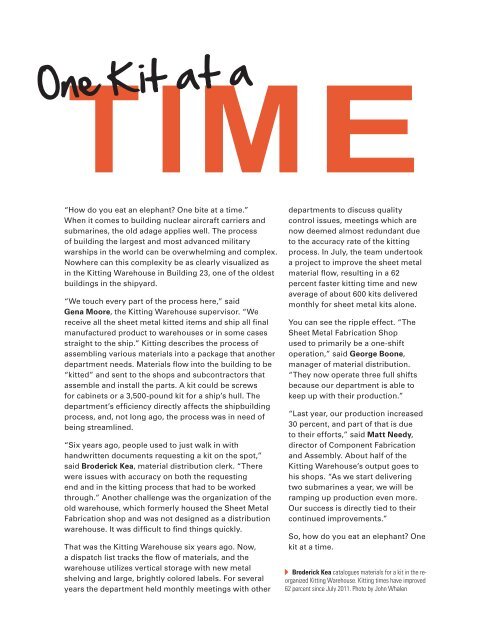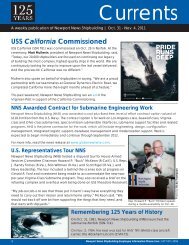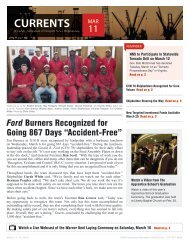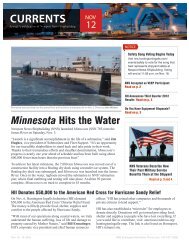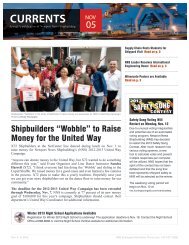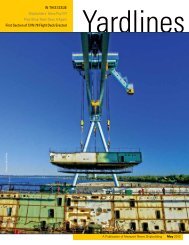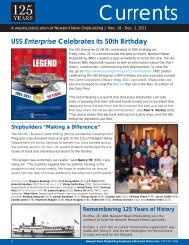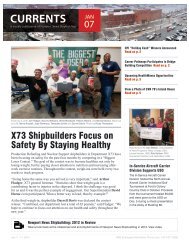Yardlines 01-02_12-2.indd - Newport News Shipbuilding
Yardlines 01-02_12-2.indd - Newport News Shipbuilding
Yardlines 01-02_12-2.indd - Newport News Shipbuilding
You also want an ePaper? Increase the reach of your titles
YUMPU automatically turns print PDFs into web optimized ePapers that Google loves.
TIMEOne Kit at a“How do you eat an elephant? One bite at a time.”When it comes to building nuclear aircraft carriers andsubmarines, the old adage applies well. The processof building the largest and most advanced militarywarships in the world can be overwhelming and complex.Nowhere can this complexity be as clearly visualized asin the Kitting Warehouse in Building 23, one of the oldestbuildings in the shipyard.“We touch every part of the process here,” saidGena Moore, the Kitting Warehouse supervisor. “Wereceive all the sheet metal kitted items and ship all finalmanufactured product to warehouses or in some casesstraight to the ship.” Kitting describes the process ofassembling various materials into a package that anotherdepartment needs. Materials flow into the building to be“kitted” and sent to the shops and subcontractors thatassemble and install the parts. A kit could be screwsfor cabinets or a 3,500-pound kit for a ship’s hull. Thedepartment’s efficiency directly affects the shipbuildingprocess, and, not long ago, the process was in need ofbeing streamlined.“Six years ago, people used to just walk in withhandwritten documents requesting a kit on the spot,”said Broderick Kea, material distribution clerk. “Therewere issues with accuracy on both the requestingend and in the kitting process that had to be workedthrough.” Another challenge was the organization of theold warehouse, which formerly housed the Sheet MetalFabrication shop and was not designed as a distributionwarehouse. It was difficult to find things quickly.That was the Kitting Warehouse six years ago. Now,a dispatch list tracks the flow of materials, and thewarehouse utilizes vertical storage with new metalshelving and large, brightly colored labels. For severalyears the department held monthly meetings with otherdepartments to discuss qualitycontrol issues, meetings which arenow deemed almost redundant dueto the accuracy rate of the kittingprocess. In July, the team undertooka project to improve the sheet metalmaterial flow, resulting in a 62percent faster kitting time and newaverage of about 600 kits deliveredmonthly for sheet metal kits alone.You can see the ripple effect. “TheSheet Metal Fabrication Shopused to primarily be a one-shiftoperation,” said George Boone,manager of material distribution.“They now operate three full shiftsbecause our department is able tokeep up with their production.”“Last year, our production increased30 percent, and part of that is dueto their efforts,” said Matt Needy,director of Component Fabricationand Assembly. About half of theKitting Warehouse’s output goes tohis shops. “As we start deliveringtwo submarines a year, we will beramping up production even more.Our success is directly tied to theircontinued improvements.”So, how do you eat an elephant? Onekit at a time.Broderick Kea catalogues materials for a kit in the reorganizedKitting Warehouse. Kitting times have improved62 percent since July 2<strong>01</strong>1. Photo by John Whalen


